
Of Preliminary Work Finished CALCUTTA - More than three quarters of the preparatory work required to put stock-piles of Base Section surplus property in shape for transference to the Indian government had been accomplished even before the final sale agreement, spokesmen for Base Section Headquarters told Roundup this week. The spokesmen estimated that all surpluses in Calcutta, Assam and Karachi would be ready for turning over to the British authorities under the new sale agreement by Apr. 11. Whether or not the final sale agreement would have any effect on the rate of personnel demobilization was not yet clear, since according to the Base Section representative, the U.S. Army must continue its custodial responsibility for the property until the new owners take possession. While the American Army might be ready to relinquish possession by April 1, spokesmen of this headquarters could not predict when the Indian government would be ready to take over the installations and materials. INVENTORY MADE The Base Section spokesmen explained that careful inventories of stocks are being made by the U.S. Army. However, he pointed out, the agreement with India provides that the new owners may make spot checks of the property if they desire to ascertain whether the American count is reasonably accurate. The officials did not expect there would be unreasonable delay in transferring the goods, because the invoices provide that the transfer is subject to final adjustments at a later date, to cover the possibility of errors in the task of inventorying the vast stocks. The Indian government will take possession of the surplus property at present locations and the U.S. is not required to furnish assistance in transporting material to suit Indian requirements, said the Base Section representative. At present the surpluses are concentrated in Chabua, Ledo and Calcutta areas with additional collecting points at Karachi, Tezgaon, Kalikunda, Ondal, Khulna and Chittagong. LARGE AMOUNT largest stockpile is in the Calcutta area, where there are approximately 252,258 long tons of surplus material scattered over many warehouses and installations. Chabua and Ledo come next with about 90,799 and 75,521. Base Section officials also pointed out that there were several other relatively minor operations left before inactivation. These included disposal of some property to UNRRA, Indo-China and private buyers; shipping property to China and the U.S. and the concentration of all war dead into Kalikunda and Barrackpore cemeteries. THEATER TO HAVE 5,700 PERSONNEL HERE MAY 1; APRIL SHIPS LISTED General movement of troops home continued this week as it was announced that the tentative strength of the Theater would be approximately 5,700 on May 1. Since V-J Day, 185,037 troops, including China Theater personnel, had been sent to the U.S. by air and water transportation through midnight Feb. 27. According to tentative figures, approximately 19,000 officers and men are now in the I-B, following the scheduled departure of the General Hodges Tuesday of this week. That figure will drop to about 12,000 on April 1. Two ships, each carrying approximately 3,200 men each, are now slated to leave in April. They are the General Heintzelman and the General Scott. The shipping list is tentatively set as follows: Marine Jumper, leaving March 22 for Seattle; Marine Cardinal, leaving March 24 for San Francisco; General Heintzelman, leaving April 16 for San Francisco; and General Scott, leaving April 27 for Seattle. Each vessel will carry about 3,200 men and will stop at Manila for refueling. Returnees were moving to the Calcutta area this week under the March quota of 6,173 to fill the two ships sailing on March 22 and 24. Theater Circular No. 35, calling for the movement of returnees under the March quota, was revised by Theater Circular No. 48 to change the quota period from 1-10 March to 1-15 March. All returnees will be processed at Replacement Depot No. 3 headquarters, now located at the 142nd General Hospital area in Calcutta. Casuals will be quartered at Camp Dum-Dum (Orphanage), Tollygunge and Camp Dhakuria, all in Calcutta, and a small group at Kanchrapara. A Theater spokesman declared that general policy is that all personnel from whom there is no military necessity will be evacuated at the earliest possible date. Particular safeguards have been set up to insure that all men eligible for release from duty by April 15 will be on their way to the Replacement Depot by that date and home or on the way by April 30. |
|
Indian Army Plans Moving Ahead Rapidly NEW DELHI - The rate at which the government of India will take possession of the U.S. Army surplus property, under the sale agreement announced last week, cannot be accurately foreseen, nor can the final date of the transfer be set, A. C. Welling, Theater G-4 told Roundup this week. Instructions from the Foreign Liquidation Commission and preparations for G-4 to do the job were nearing completion this week. Maj. Gen. E. Wood, Master General of Ordnance for the Indian Army, has taken charge of taking over property peculiar to the Indian Army and is setting up procedures for transferring the property to the Government of India. Two officers are leaving in a few days for Assam, to give the turnover job "a kick in the pants." The general is optimistic about the speed of the transfer, and well-integrated procedures have been set up for the process. INDIA'S PLANS The India Air Headquarters is setting up plans for the takeover of installed U.S. equipment on airfields. No agency has yet been designated for taking over surplus USAAF stores. For the transfer of stores, exclusive of equipment and installed facilities and exclusive of bulk gasoline, canteen stores and animals, the Indian Army has planned two types of organizations: (1) In Assam and Calcutta, they will have field organizations specifically set up for the takeover, reporting directly to the general in Delhi for instruction. (2) At location s such as Agra, Karachi and Delhi, where there are existing Indian Army ordnance depots, the local ordnance depot will be assigned responsibility for the takeover of U.S. stores. Appropriate sections of the Indian Government will take over animals, bulk gasoline, canteen stores, installed signal communications, and installed machinery. The transfer of these will be an insignificant part of the whole job.
|
ONLY 24 ATC PLANES REMAIN IN I-B SKIES
CALCUTTA - ATC's India-China Division, whose legions of transports conquered the Hump to make aerial history, is no more.
With their once tremendous fleet down to 24 planes on the first of March, ICD recently became part of the North African Division with headquarters at Casablanca, leaving behind the 1,304 Indian Wing Base, with headquarters at Barrackpore and six small operating locations scattered through India and Southeast Asia.
Brig. Gen. Charles W. Lawrence, ICD's last chief, took over command of the North African division concurrently with the abandonment of the division in I-B.
A mass exodus of ICD C-54's back to the U.S. paved the way for the scaling down of ATC operations in India. Bay March 1, only four of the big planes were left in India. The rest were flown back to Westover Field, Mass.,
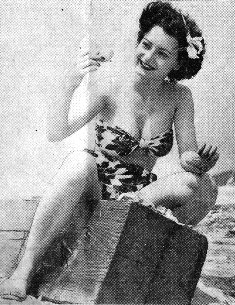 Presenting Lynn King, who digs for clams. Who she is or what she does or even where we got this picture we don't know,
but we like clams. Could be that's why we're running this picture.
Presenting Lynn King, who digs for clams. Who she is or what she does or even where we got this picture we don't know,
but we like clams. Could be that's why we're running this picture.
|
Spokesmen for the India Wing said they hoped contract carriers would begin this operation in early March to supplement ATC schedules. They explained that the contract carrier system did not yet mean that commercial airlines were taking over the route. They stated that the contracting commercial company simply supplies pilots and ground maintenance for ATC ships under this plan, while the Army retains full operational control over the planes.
Pilots and ground crew members of contract carrier ships, the spokesmen said, are civilians, receiving Stateside commercial airline pay, plus overseas bonuses, but are subject to military law and control.
A small contract-carrier crew has been stationed at Barrackpore since October last year. They told Roundup their personnel is furnished quarters and rations by the Army for which they pay on the same basis as Army officers. Contract-carrier civilian crews do general maintenance work on their ships, while the Army services the ships with gas, air and such items and does occasional major repair work for which the contract-carrier has no facilities.
The spokesman for India Wing ATC said that all C-54's returned to the States with a full passenger list, with the exception of three ships which were mechanically unsafe for passenger carrying. He stated that homeward bound passengers were divided between Air Force personnel and high-priority men designated by Theater headquarters.
Of the ships still remaining in India as of March 1, only four are C-54's. Eighteen C-47's remain, while the remainder of the fleet consists of one L-5 for search and rescue work and a B-25 used for DDT spraying. One of the scarce C-54's is a plush passenger job.
 Winner of the Piccadilly beauty contest in New Delhi recently is Cynthia M. Wheeler, a secretary in QM, New Delhi.
Winner of the Piccadilly beauty contest in New Delhi recently is Cynthia M. Wheeler, a secretary in QM, New Delhi.
|
|
Shift To Use Of C-47s The workhorse of the air war, the Army's C-47 Douglas twin-engined transport plane, returned to its dominant air role in the I-B Theater last week when the India Wing of the Air Transport Command issued a new Theater flight schedule effective Mar. 1. Reductions of the Theater strength and ATC personnel renders the four-engined C-54 superfluous to I-B flight needs and they are being returned to the U.S. The new schedule is as follows (Local time in all cases):
All other services will be on a special mission basis. |
 Paramount starlet Catherine Craig smiles happily before her swimming pool because hubby Robert Preston is back
home from the Air Corps.
Paramount starlet Catherine Craig smiles happily before her swimming pool because hubby Robert Preston is back
home from the Air Corps.
|
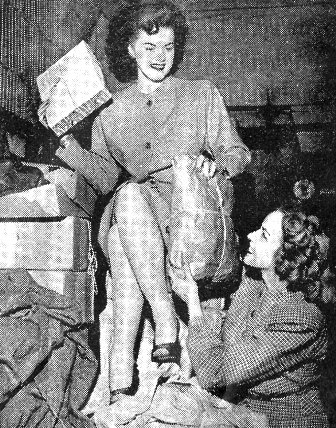 Models Lynne Walker (top) and Ruthellen Merlyn are shown with clothing gathered for overseas relief. City-wide
collection in Chicago for usable garments, shoes and bedding is now in progress.
Models Lynne Walker (top) and Ruthellen Merlyn are shown with clothing gathered for overseas relief. City-wide
collection in Chicago for usable garments, shoes and bedding is now in progress.
|
As Brothels Go Mobile
CALCUTTA - Prostitution has gone mobile here in recent months.
In what is apparently a big campaign to rake in the dough before the GI's are gone for good, not only have Calcutta's brothels increased their numbers and put on more "salesmen," but the frowsy "filles de joie" have taken to mobile operations in taxis and gharries, too.
The result has been a jump in the venereal disease rate from about 64.8 cases per thousand troops per year in August, 1945, to roughly 612 cases per thousand per year as last reported in mid-February.
Whatever other views one may have about VD, one thing is sure - it raises Hell with a man's hopes of going home. The Base Surgeon reports that "innumerable men have been delayed in returning home because of venereal disease and its treatment, but what the men do not realize is that a number of prostitutes in addition to having several venereal diseases, also have tuberculosis or leprosy."
"There is a case at the present time in the hospital which has been treated for two months," and only now is being returned to the states for further treatment," says the surgeon. "Many men have the erroneous idea that syphilis and gonorrhea can be cured immediately by the use of penicillin and sulfa drugs. "However, all cases of syphilis must be observed for at least one year with several spinal taps."
Take the case of a recently homeward bound warrant officer. MP's picked him up one Saturday night at a Terrati bazaar brothel. Next morning, he failed to report to the Chief of Administrative Section, as directed. A search for him was conducted. He was already aboard the USS General Ballou but was yanked off the boat and eventually got a court martial.
Calcutta's unglamorous courtesans provide the medics with some rare and odd specimens of VD. They may be interesting to doctors as prize examples of little known diseases - but the GI who contracts them invariably wishes "he knew then what he knows now."
Calcutta's brothels are one place where a "home run" is not necessarily an enviable achievement. "Home run" is the medics pet name for the numerous cases in which one man contracts all four venereal diseases from one contact.
Base Surgeon's statistics indicate that 30 percent of venereal disease cases come from brothels, while 70 percent arise out of "pickups" and mobile operations in gharries and taxis. However, it might be a little risky to conclude that chances are better in a brothel.
The point is that a lot of GI's with VD will report that they contracted the case from a "pickup" in order to avoid possible punishment for being "out of bounds" in a brothel.
 After nearly two years as a focal point for Air Force operations in the I-B and China Theaters, the Warren Hastings
Jute Mill, in which the Theater AAF housed its headquarters, will revert to its civil proprietors. Above, Brig. Gen.
Thomas B. McDonald, commanding general of the I-B AAF addresses Air Forces personnel in the final retreat ceremony at
Hastings Mill. The new AAF headquarters has moved across the Hooghly River to the Bengal Air Depot at Titaghur.
After nearly two years as a focal point for Air Force operations in the I-B and China Theaters, the Warren Hastings
Jute Mill, in which the Theater AAF housed its headquarters, will revert to its civil proprietors. Above, Brig. Gen.
Thomas B. McDonald, commanding general of the I-B AAF addresses Air Forces personnel in the final retreat ceremony at
Hastings Mill. The new AAF headquarters has moved across the Hooghly River to the Bengal Air Depot at Titaghur.
|
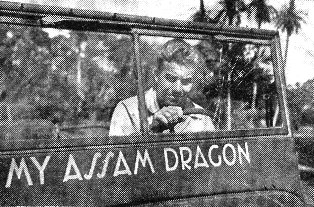 Specialist Third Class John E. Beltz, of SSU Detachment 404, drives one of the better known jeeps in Singapore.
That title has been seen, quite appropriately, too, in GI sectors of India and Burma.
Specialist Third Class John E. Beltz, of SSU Detachment 404, drives one of the better known jeeps in Singapore.
That title has been seen, quite appropriately, too, in GI sectors of India and Burma.
|
Only 23 Lived To Tell Of Jap Sea Murder
CALCUTTA - There are only two soldiers left to tell this story.
One of them is Major J. J. Gussak, Provost Marshal of Base Section and formerly a Brooklyn lawyer. The other is Pvt. Harvey Matyas, who was stationed at Dinjan and who now is in Milwaukee.
They are the only Army survivors of the Jean Nicolet, a Liberty ship which on July 2, 1944, was torpedoed and sunk in the Indian Ocean. And of the total of 100 armed guards, merchant seamen, civilians and soldiers aboard, only 23 lived to describe the war crimes committed by members of the submarine's crew.
It was a still, dark night and the Jean Nicolet, carrying along without escort, was only three days out of Colombo, Ceylon. Those aboard her, dulled by the monotony of 52 days at sea, began to awaken to the fact that they would soon rid themselves of the confining existence. The CBI Theater wasn't far away.
Then the torpedo struck. It was a direct hit. One lifeboat was blasted away, but three others were loaded quickly and were moved away from the burning vessel. The armed guards, spoiling for action, gathered on the main deck, but no enemy could be seen through the smoke and darkness. The night seemed a black shroud to the demise of Jean Nicolet.
The ship's master ordered all to abandon ship. The armed guards scrambled down to the raft, followed by Major (then Capt.) Gussak, the ship's master and another Naval officer.
FOUND BOATS
"We got away just as the ship began to flare up," said Gussak. "In about half an hour, we ran across the No. 4 lifeboat, which was equipped with a motor. The master was transferred to No. 4 and it cruised off to collect the other boats so as to bring us all together. That left a Navy lieutenant and myself on the raft, along with from 12 to 15 of the armed guards.
"Shortly after the motorboat left, the Jap submarine surfaced, shelled the Jean Nicolet, then cruised about and captured No. 4 lifeboat. The sub moved to our raft and captured it, though five of the men managed to escape. The five included the lieutenant who leaped off and swam away amidst hails of machine gun fire - and Pvt. Matyas, who likewise remained afloat after hitting the water.
"The other two boats also were captured and 95 of us were taken aboard the sub. We were roboed, our life preservers were taken off and our hands tied behind our backs. All of us were taken to the forward deck and compelled to sit down cross-legged in a column of fours, facing forward.
"We were held captive for about three hours, during which time many of the men received blows on the head for various reasons and some were struck for no reason at all."
After the Japs had finished interrogating all the prisoners, they began a system of annihilation. "The men were taken to the rear of the conning tower," continued Gussak. "There they were either hit on the head or bayoneted and then pushed overboard with their hands still tied behind their backs. About 60 to 65 men were killed in this manner."
With one-third of the job still remaining, the Japs suddenly dashed below and the sub was crash-dived at about 10 a.m. It was assumed they had picked up a warning from an approaching patrol plane.
Those who remained, about 30, were pulled down by the suction of the diving sub - and a couple of them were trapped and drowned. The others slipped free of the deck and were left to struggle in the water with their hands tied behind their backs and with no life preservers. During the night, about a dozen of these men drowned.
"I kicked around in the water and shouted," said Gussak. "It must have been about an hour later that one of the men swam up and undid my bonds. I had been tied with wire and still carry the scars on my wrists. I never did learn the name of the man who rescued me, but I must say that the conduct of all the men was excellent."
SHIP SINKS
Gussak, who was 44 years old at the time, floated all night and vainly tried to reach the Jean Nicolet, which finally sank at 9 a.m. the next day, July 3. Three planes came over during the morning and about noon he reached a raft which had been dropped by one of the planes. Six others also got to the raft, all of them having been able to stay afloat when the planes threw down Mae Wests to them.
"We were aboard the raft until about 11 a.m. on July 4, when a small armed trawler of the Indian Navy picked us up. The trawler had previously gathered up 16 others.
"It was then I learned that of the 95 men dragged aboard the sub, only 18 had survived. These men had been in the water, with no support, for from 14 to 17 hours when they were rescued."
The next day, the men were landed at Addu Atoll in the Maldives Islands. Another Indian vessel picked them up on July 12 and they were taken to Colombo. Further transportation was provided and they reached Calcutta without additional adventure.
For the experience, Major Gussak has his scars, the Purple Heart, a Bronze Star Medal and a battle star.
"If anyone else wants to earn 15 points the same way, they're welcome to it," is Gussak's hearty conclusion.
Doomed Fliers' Letters Found
TOKYO - (UP) - During the final hours before they were executed, three of Jimmy Doolittle's first Tokyo raiders wrote farewell letters to their families and sweethearts in the United States, it was disclosed last week.
Mimeographed copies of the letters were recovered from the files of the Japanese War Ministry, it was reported, and will be forwarded to Shanghai for use by the prosecution in trials of Japanese war criminals.
The letters were written by Lt. Will Osborn, Darlington, S.C., Lt. Dean Hallmark, Dallas, Tex., and Sgt. Harold Spaatz, Lebo, Kan., during the first shock of knowing that they had been doomed to death.
Hallmark wrote to his family: "I hardly know what to say. They just told me I am liable to execution. I can hardly believe it I have been a prisoner of war for days."
GIRLS START WORK ON I-B 'BOARDS'
"Numbah, puh-leese," and a sweet, feminine voice greets you at the other end of your GI line.
Yessir. Suzy's back at the switchboard, for the Theater Signal office began last week to break in civilians to supplement GI operators. Previously, the only place to employ women operators was Karachi, where there was a manpower shortage and the boards were small and easy to operate anyway.
Now women are being engaged in Calcutta and New Delhi, not only for switchboard work, but as teletype operators as well. The teletype operators include civilian men and were chosen for their typewriting ability, since no one had any experience on a teletype machine.
But as far as "Switchboard Suzy" goes, it's clearly her own stamping ground. Even the GI's conceded the girls take to it like a bubble bath.
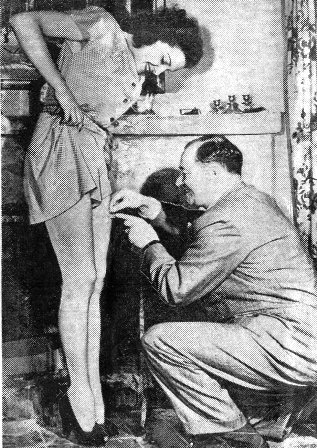 With full authority of the Hosiery Designers of America behind him and actress Jane Russell's shapely gams before
him, Willy De Mond measures them for a fitting with nylons as Jane coyly lifts her skirt. De Mond says la Russell has
the most perfect pair of legs in Hollywood. Anybody disagree?
With full authority of the Hosiery Designers of America behind him and actress Jane Russell's shapely gams before
him, Willy De Mond measures them for a fitting with nylons as Jane coyly lifts her skirt. De Mond says la Russell has
the most perfect pair of legs in Hollywood. Anybody disagree?
|
NEW DELHI - American troops in the Delhi area will shed their winter garb of "ODs" for the summer khaki uniform today (Thursday), it was made known this week by ADMAC officials.
Malaria control regulations also will be enforced as of the same time.
 Mrs. Sam Appling of Atlanta, Ga., knows what it is to cook for her five sons, all recently returned from the war.
They ate a 450-pound ham in less than a week. Shown together for the first time in five years are Bufford, 25, Dewey,
27, Hugh, 28 and twins Ray and Fay, 22, who served in the CBI.
Mrs. Sam Appling of Atlanta, Ga., knows what it is to cook for her five sons, all recently returned from the war.
They ate a 450-pound ham in less than a week. Shown together for the first time in five years are Bufford, 25, Dewey,
27, Hugh, 28 and twins Ray and Fay, 22, who served in the CBI.
|
Singapore Scene Of Hectic Life For Many Races
Roundup Man Makes Visit To Jap Trials
By SGT. ED ALEXANDER Roundup Staff Writer
SINGAPORE - This modern waterfront Oriental crossroads city lives a hectic life reminiscent of the last days of the Roman Empire.
Allied troops, tired, lonesome and far from home, raise hell in the city's teeming night spots; once-rich Dutch exiles from the Indies while away the time in dreary internment camps with hollow desperate gayety, and downtown in the city the Chinese and Malayan population seems ready to boil over with demonstrations, strikes and British armored cars patrolling the streets.
Not much physical damage from the war can be seen in Singapore, but Singapore seems less recovered from the economic consequences of battle than any other city I visited in this area. Prices are fantastic. GI's receive $2.25 per diem here, but their mess bill is $2.25 per day.
A good dinner downtown costs about $5 American. Two GI's once ordered steaks, and received a bill for $25! There is plenty of gayety in Singapore's "Worlds" - the Happy World, the Great World and so on. These are Steeplechase-like amusement centers, covering several brightly-lit square blocks, enclosing tea shops, souvenir stalls, theaters, boxing arenas and most of all - the dance halls.
PRETTY HOSTESSES
You can have a beautiful Chinese hostess sit with you at your table - for $6 per hour, plus drinks. Once you could buy alcohol beverages in the World's - $2.50 for a quart of beer - but so much hell was raised, the drinks were forbidden. Now you can buy orangeade for 50 cents a glass!
In Singapore's modern courthouse, the first of the War Crimes Trials is taking place. I spent one morning at the trial of Pvt. Morata Yoshitaro, one of five Japs charged with atrocities against Chinese civilians which resulted in three deaths.
The conduct of the Jap war crimes suspects in the prisoners' dock is still unfathomable. Pvt. Yoshitaro stood at attention in the dock for a full hour and a half hardly moving except to give perfunctory answers to questions asked.
With a number hung around his neck, he looked like a wooden bell. Only occasionally did his face change - and then merely to look up at the ceiling for answers to tough questions. There were a lot of things he "couldn't remember."
Out at streamlined Changi jail the Jap suspects await trial. It is impossible to report on conditions under which war criminals and suspects are held, since I was denied admission to the jail by the British military authorities.
The approximately 130 American military personnel here live the usual Southeast Asia life of GI luxury. Mt. Pleasant was formerly a luxurious area of big homes, reminiscent of Beverly Hills or North Hollywood, lived in by wealthy American and British business men. Now the Army has taken over the whole area.
LAST WACS
The outfits here are a Liaison Detachment, Strategic Service Unit Detachment 404 and a small ATC operating location. Singapore boasts the last WACs in the Theater - about 18 veterans of SEAC's Ceylon days.
Almost all the WACs are eligible to go home, but have volunteered to stay on because as one girl put it, "few of us have any ties in the States. Why not see as much of the world as possible while we have the chance?" A lot of the Singapore WACs hope to go on to Shanghai soon.
Brig. Gen. Thomas S. Timberman, Army chief down here, explained the functions of American personnel in Southeast Asia. He enumerated as some of their jobs: assisting with State Department functions until the Department can return to its pre-war work; helping promote the interests of American business in the area; maintaining ATC facilities until commercial airlines can take over; maintaining liaison with SEAC; removal of American war dead; supervision of SSU activities; exercising custodial responsibility for surplus property.
I talked to a lot of GI's in Singapore. That wasn't hard, because they came rushing. They're glad to admit they have probably the "best deal" of any GI's in the world. They agree that someone has to carry on the functions of the Army in Southeast Asia.
But every man I spoke to asked me to put in Roundup their opinion that there are at least twice as many GI's here as are necessary to do the work.
They pointed to the fact that Wednesday afternoons and Saturday afternoons have been declared "time off" because of lack of work, on top of all day Sunday. The GI's I spoke to said that for the rest of the week they put in barely three hours work per day.
 Snatches of what goes on in Singapore, crossroads of the Orient. (Left) At the "Happy World," S/Sgt. Max Buran of
SSU Det. 404 dances with "Venus," dance hall queen. (Right) International relations at their best are exemplified
in this meeting: Left to right - Pfc. Louis J. Williams, Anna Lee, Molly Chu and Pvt. Richard Graber of the Dutch Army
- at the "Great World" night club. The two girls are hostesses.
Snatches of what goes on in Singapore, crossroads of the Orient. (Left) At the "Happy World," S/Sgt. Max Buran of
SSU Det. 404 dances with "Venus," dance hall queen. (Right) International relations at their best are exemplified
in this meeting: Left to right - Pfc. Louis J. Williams, Anna Lee, Molly Chu and Pvt. Richard Graber of the Dutch Army
- at the "Great World" night club. The two girls are hostesses.
 (Left) GI "barracks" - Singapore style. T/3 Robert Fairbanks and S/Sgt. Max Buran relax during the lunch hour at SSU Det.
404's mansion atop Mount Pleasant. (Right) Pvt. Muorata Yoshitaro, Jap POW, stands in the prisoners' dock at
Southeast Asia War Crimes Trials. A member of the U.S. War Crimes Commission staff is seated on the left.
(Left) GI "barracks" - Singapore style. T/3 Robert Fairbanks and S/Sgt. Max Buran relax during the lunch hour at SSU Det.
404's mansion atop Mount Pleasant. (Right) Pvt. Muorata Yoshitaro, Jap POW, stands in the prisoners' dock at
Southeast Asia War Crimes Trials. A member of the U.S. War Crimes Commission staff is seated on the left.
 "No, Mom, I won't get off Wilbur's lap - I was here first!"
"No, Mom, I won't get off Wilbur's lap - I was here first!"
|
TAILOR BOASTS LONG SERVICE
Perhaps the civilian tailor who has been sewing on CBI patches and pressing pants the longest for India-Burma wallahs is S. Lal Malhotra of New Delhi. He's been sewing on chevrons for GI's since August, 1942, when the 10th Air Force had its headquarters up here in northern India and the Japs were pushing through Burma.
Besides regular tailor duties, Mr. Malhotra at one time provided a variety of concessions to the Theater headquarters' men in the form of jewelry, curios and even a restaurant at the old Irwin Road tent city, the airport and ARC's Duration Den before the present living quarters in New Delhi were available.
Mr. Malhotra has letters of recommendation from generals to privates who have patronized his establishments and is quite proud of his work. He recalls many of the old brass who made I-B history during the war.
He even designed the AACS and ATC India-China Division emblems when both units were in Delhi. When they moved to Hastings Mill near Calcutta, Malhotra opened a tailor shop there, too.
Mr. Malhotra manufactures fancy CBI shoulder patches with silver thread, overseas bars with gold thread, and the "Eisenhower" jacket, which is the leading fad these days.
When the call came for a tailor concession for Theater headquarters troops in 1942, Mr. Malhotra, who had been tailoring for His Majesty's Forces in Delhi for over 35 years, was selected.

MARCH 7, 1946
Original issue of Roundup shared by CBI veteran Jay Anderson
Copyright © 2006 Carl Warren Weidenburner
ADDITIONAL INFORMATION ON THE SINKING OF THE JEAN NICOLET
TOP OF PAGE PRINT THIS PAGE ABOUT THIS PAGE SEND COMMENTS
PREVIOUS ISSUE CLOSE THIS WINDOW NEXT ISSUE
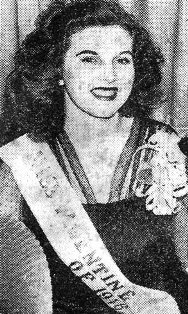 Mary C. Lewis, 18, of Hot Springs, S.D., a War Department employee, was named "Miss Valentine" at a Washington ball.
Mary C. Lewis, 18, of Hot Springs, S.D., a War Department employee, was named "Miss Valentine" at a Washington ball.